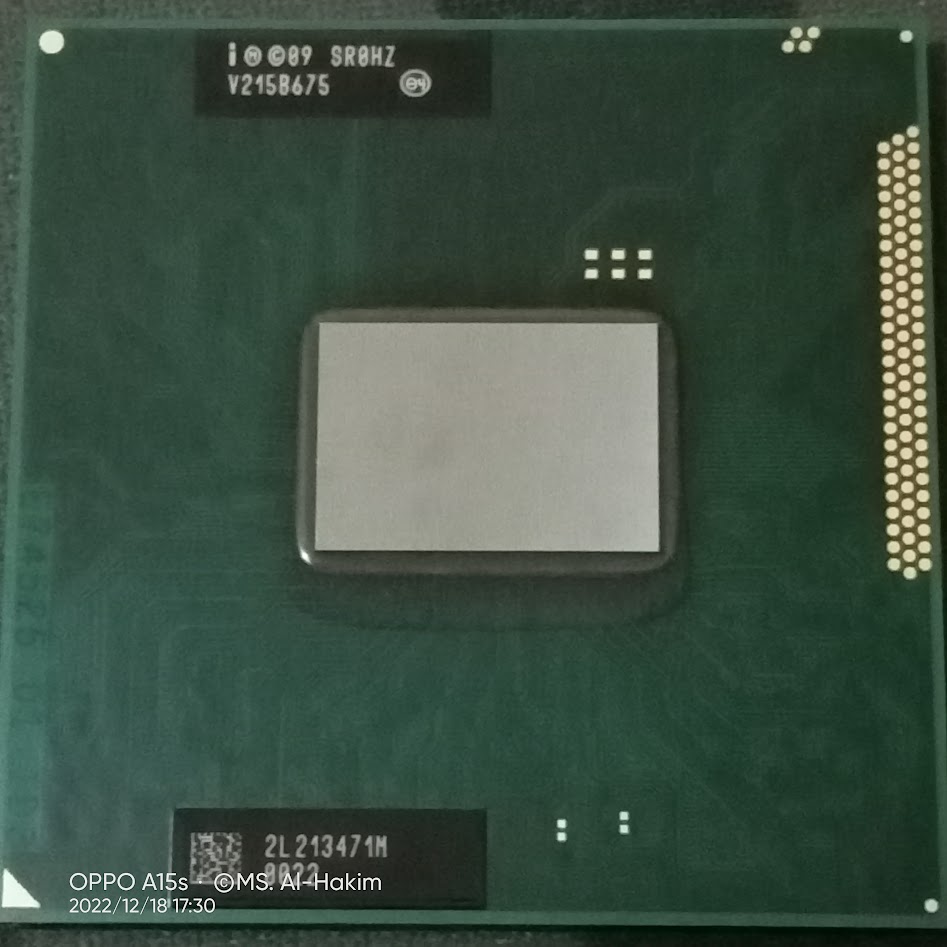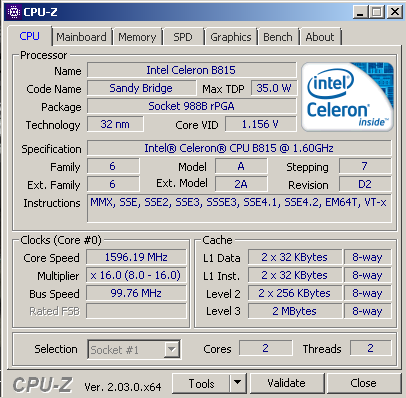Comparing: Intel Celeron N2815 vs Intel Celeron B815
In this comparison, we analyze two Processors: Intel Celeron N2815 and Intel Celeron B815, using synthetic benchmark tests to evaluate their overall performance. This side-by-side comparison helps users understand which hardware delivers better value, speed, and efficiency based on standardized testing. Whether you're building a new system or upgrading an existing one, this benchmark-driven evaluation offers valuable insights to guide your decision.

Intel Celeron N2815
| Type: | Processors |
|---|---|
| Brand: | Intel |
| Model: | Celeron N2815 |
Specification Comparison Table
This specification comparison presents technical details of several devices or components to help you understand the key differences between each option. Use this table as a reference to determine which device best suits your needs.
| Specification | Intel Celeron N2815 | Intel Celeron B815 |
|---|---|---|
| Architecture | x86 | x86 |
| Technology | 22 nm | 32 nm |
| Clock | 1.86 GHz - 2.13 GHz | 1.6 GHz - - |
| Core/Thread | 2 / 2 | 2 / 2 |
| Segmen | Mobile | Mobile |
Submission Comparison Table
This submission comparison table displays the number and details of benchmark data submissions from various devices or components. This information helps you understand the performance based on the benchmarks that have been tested, as well as providing an overview of the consistency and popularity of the available benchmark results.
| No. | Benchmark Software | Intel Celeron N2815 | Intel Celeron B815 |
|---|---|---|---|
| 1 | PiFast |
1min, 28sec, 750ms |
47sec, 490ms |
| 2 | SuperPi - 1M |
40sec, 513ms |
24sec, 976ms |
| 3 | wPrime - 32M |
47sec, 267ms |
41sec, 44ms |
Submission Comparison Chart
This chart visualizes the benchmark scores comparison between two hardware devices based on submitted data.
Media Gallery
A collection of photos of tested hardware. These images can help you identify the physical form, model, and variant of the hardware in question. These photos are from our own documentation, and if they are not available we may not be able to document them.
About Hardware Intel Celeron N2815
The Intel Celeron N2815 is a power-efficient processor released in 2013 as part of the Bay Trail-M family, aimed at entry-level laptops and lightweight computing devices. It has 2 cores and 2 threads with a base speed of 1.86 GHz that can increase to 2.13 GHz thanks to Intel Burst Performance technology. Built using a 22nm fabrication process, the N2815 comes with a TDP of only 7.5 watts, making it one of Intel's most efficient processors in terms of power consumption for the low-end class. This makes it very suitable for portable devices such as netbooks or mini laptops that prioritize battery life over high performance.
On the graphics side, the Intel Celeron N2815 is equipped with an integrated Intel HD Graphics (Bay Trail) GPU that runs at a base frequency of 313 MHz and can reach up to 756 MHz under certain conditions. This GPU is capable enough to run desktop displays smoothly, and supports 720p video playback. However, for heavy graphics tasks such as playing modern 3D games, video editing, or graphic design, this GPU is clearly not capable. Its use is more suitable for everyday computing such as opening documents, browsing the internet, playing standard videos, and running light office applications.
In terms of overall performance, the Celeron N2815 is sufficient for running light operating systems such as Windows 7 or light-based Linux distributions such as Lubuntu or Linux Mint XFCE. However, due to its simple architecture and low single-threaded performance, users may experience limitations when running multiple applications at once or when opening software that requires higher computing power. In tests using an Asus X200MA laptop with 2GB DDR3 dual channel RAM and Windows 7 operating system, performance was good enough for basic use, although it was slow when running modern applications or multitasking.
Overall, the Intel Celeron N2815 is a decent processor for light computing needs with low power consumption and an economical price, but it is not recommended for heavy productivity tasks or long-term use on modern operating systems.
Hardware Detail:
Device: Asus X200MA
RAM: 2GB Dual Channel
OS: Windows 7
Saturday, 07 May 2022 13:02:41 | Update: 1 month ago
About Hardware Intel Celeron B815
The Intel Celeron B815, released in 2012, is an entry-level mobile processor based on the Sandy Bridge architecture. Designed for budget laptops, it features 2 cores and 2 threads with a fixed clock speed of 1.6 GHz. The processor does not support Turbo Boost or Hyper-Threading, limiting its multitasking capabilities.
Manufactured using 32nm process technology, the Celeron B815 has a TDP of 35W, which is relatively high for a low-end mobile CPU. This higher thermal output typically results in shorter battery life and more heat generation compared to modern low-power processors.
For graphics, the processor is equipped with Intel HD Graphics 2000, which runs at a base frequency of 650 MHz and can boost up to 1.0 GHz. While not suitable for gaming, this integrated GPU handles basic visual tasks like 720p video playback, simple animations, and light graphical workloads adequately.
In everyday usage, the Celeron B815 performs best with lightweight applications such as web browsing, word processing, and playing standard-definition videos. However, it struggles with modern operating systems, multitasking, and heavier workloads due to its limited core/thread count and lack of advanced CPU features.
Hardware Detail:
Device: SAMSUNG 300E4Z
RAM: 4GB DDR3 Dual Channel
OS: Windows 7
Sunday, 27 November 2022 02:25:40 | Update: 1 month ago



